














Now stronger and even more durable - the PENN® Battle® IV continues its tradition of being the workhorse of saltwater spinning reels. Newly upgraded with the Hydro Armor™ System and additional seals, the Battle IV is even more protected against saltwater intrusion and corrosion. An updated design eliminates through-holes in the spool body to further protect the reel from unwanted debris infiltrating its body and handle. Available in nine sizes and select high speed models, you can count on the Battle IV to have your back in any fight. PENN. LET THE BATTLE BEGIN™
By Ben Martin, Editor in Chief
Angling is more than just catching fsh—it’s a deeply rooted tradition that transcends generations, embodying a way of life, an art, and a profound source of pride. Tis pride isn’t merely in the size of the catch but in the entire experience, the skills refned over time, and the deep connection with nature.
Central to this pride is the mastery of technique. Whether it’s fy fshing in a mountain stream, casting a net in coastal waters, or patiently waiting with a rod and reel on a quiet lake, angling techniques require patience, practice, and a deep understanding of the environment. Anglers take pride in perfecting their skills—learning to read the water, understanding fsh behavior, and selecting the right equipment. Each successful cast, cleverly tied knot, and well-chosen lure is a testament to an angler’s dedication.
Te true pride in angling lies in the knowledge gained through experience. Seasoned anglers refect on the countless hours spent mastering their sport, from how a fy lands on the water to recognizing subtle signs of fsh activity. Angling is a journey of continuous learning, where each

trip ofers new lessons and insights, further fueling this pride.
Angling also nurtures a deep connection with nature. Being out on the water, enveloped in tranquility, allows anglers to develop a profound respect for the environment. Pride in angling is ofen linked to this connection, as anglers feel a sense of responsibility toward preserving waterways and fsh populations for future generations.
Tis respect for nature is vital to the angling tradition. Anglers ofen become conservation advocates, understanding that their sport’s enjoyment is tied to the environment’s health. Tus, pride in angling also includes a commitment to sustainable practices, ensuring that fsh stocks are maintained and habitats remain unspoiled.
For many, angling is a tradition passed down through generations. Te pride in angling is not just personal but a continuation of family or community heritage. Memories of fshing trips with parents or grandparents are cherished, and the skills learned are ofen passed on to the next generation. Tis sense of continuity creates a

bond that is both personal and collective, linking individuals to their past while forging connections with future anglers.
Te pride in being part of such a longstanding tradition is immense. Anglers feel a deep responsibility to honor the practices and ethics taught by their predecessors; ensuring the spirit of angling is preserved. Whether teaching a child to tie a knot, sharing stories of great catches, or passing on the secrets of a favorite fshing spot, the pride in angling is about nurturing a love for the sport that endures across time.



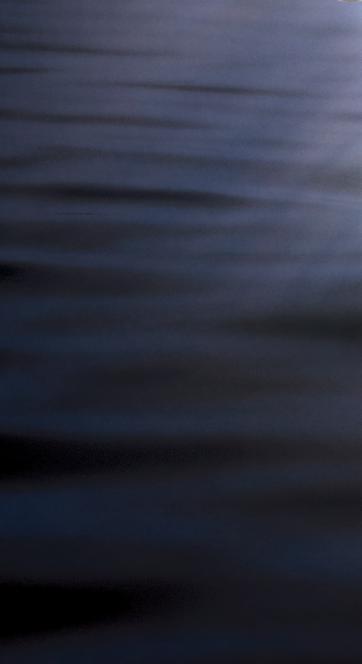








You’re looking at it! Furuno’s award-winning Radar gives you clarity & target separation like no one else. Don’t take our word for it. See for yourself. Scan here, and we’ll show you! DRS4DNXTDRS6ANXT





Selecting the right cast net is crucial for successful fshing. Here are a few tips to help you choose the best net for your needs.
1. Water Depth
Water depth afects the size of the net you should use. In shallow waters, opt for a smaller net with a shorter radius for easier control and retrieval. For deeper waters, a larger net covers more area, increasing your catch potential, but it may be harder to handle.
2. Targeted Fish Species
Te type of fsh you’re targeting determines the mesh size you need. Smaller fsh, like baitfsh or shrimp, require a smaller mesh to prevent escape. Larger fsh beneft from a larger mesh, which reduces water resistance and prevents the fsh from tearing the net.
3. Casting Ability
Your skill level should infuence your choice of net. Beginners should start with smaller,

lighter nets, which are easier to cast and control. Experienced anglers might prefer larger nets that cover more area, though they require more strength and technique.
4. Strength and Weight
may lack durability.
5. Mesh Size
Representatives from Tennessee Wildlife Resources Agency, Tennessee Department of Tourist Development, and Tennessee State Parks celebrate the ribbon cutting of the Bill Dance Signature Lakes project at the Bassmaster Classic in Knoxville on March 25, along with the project’s namesake. Photo Courtesy of the Tennessee Department of Tourist Development:
Balancing strength and weight is key. Te net must be strong enough to handle the catch but light enough for comfortable use. A heavy net can quickly become tiring, while a too-light net
Choose a mesh size based on the fsh species and environment. Smaller mesh sizes are better for small fsh, while larger meshes suit bigger fsh and allow the net to sink faster.
By considering water depth, target species, casting ability, and net strength, you can choose a cast net that enhances your cast netting success.




























Embarking on the open water is an exhilarating experience, flled with the promise of adventure and relaxation. Whether you’re a seasoned sailor or a weekend cruiser, protecting your vessel with proper insurance is not just a choice—it’s a necessity. Explore the reasons why every boat owner should prioritize boat insurance for a worry-free voyage.
The open water can be unpredictable, with unexpected storms, collisions, or other potential accidents. Boat insurance can give you fnancial protection if there is damage to your vessel, providing coverage for repairs or replacement.
Accidents on the water can result in damage to other boats, docks, or even injuries to passengers. Boat insurance offers liability coverage, which can pay for damages or injuries you’re liable for while boating, up to specifed limits, and lawsuit costs if you’re sued. This includes damage you cause to another watercraft or if someone on or near your boat is injured and you’re found to be legally responsible.
Unfortunately, boat theft and vandalism are realities that boat owners face. Boat insurance has comprehensive and collision coverage that can protect you against events outside of your control, including theft and vandalism.
Accidents on the water may lead to injuries for you or your passengers. Boat insurance offers a range of optional medical payments coverage limits, helping to cover medical expenses if you are in an accident or someone is hurt on your boat, regardless of fault.
If you fnanced the purchase of your boat, most lenders require insurance coverage to protect their investment. Having boat insurance not only fulflls these requirements but also gives you peace of mind knowing that your fnancial interests are safeguarded.


Some water municipalities and marinas may require proof of insurance for docking or accessing certain areas. Boat insurance allows you the fexibility to explore different destinations without worrying about entry restrictions.
Emergency towing and assistance
Progressive boat insurance can include optional Sign & Glide® On-Water Towing coverage. If your boat is disabled or breaks down on the water, Sign & Glide® pays for on-water towing, jump starts, soft un-groundings, and fuel delivery.
Wreckage removal
If your boat sinks, Progressive boat insurance will cover the cost of removing your boat from the water (if removal is legally required).
Investing in boat insurance is not just about protecting a valuable asset; it’s about safeguarding the memories, experiences, and joy that come with your on-water adventures. Don’t let unforeseen circumstances disrupt your journey—navigate with confdence, knowing that Progressive boat insurance has you covered. Ensure a smooth and worry-free voyage, because when it comes to your boat, peace of mind is the ultimate luxury.
Scan to get a quote in as little as 4 minutes
learn more.























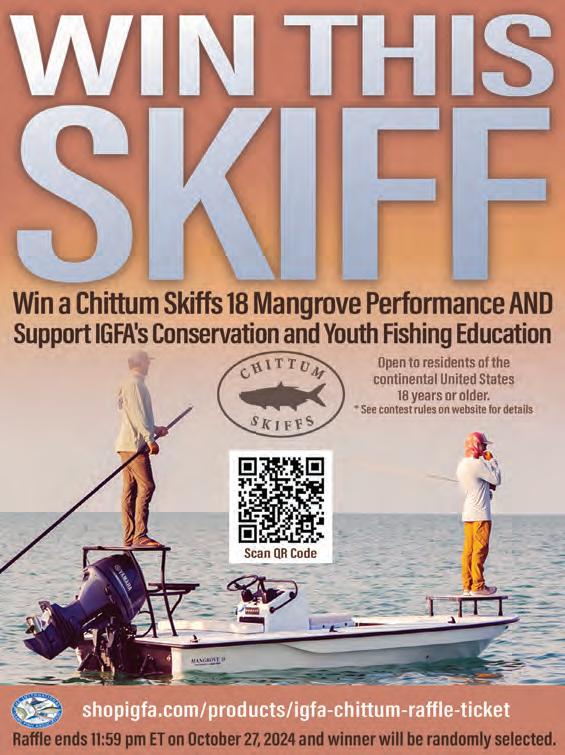



ITim Barefoot
t’s kinda like the old Byrds song “For everything, there is a season…”
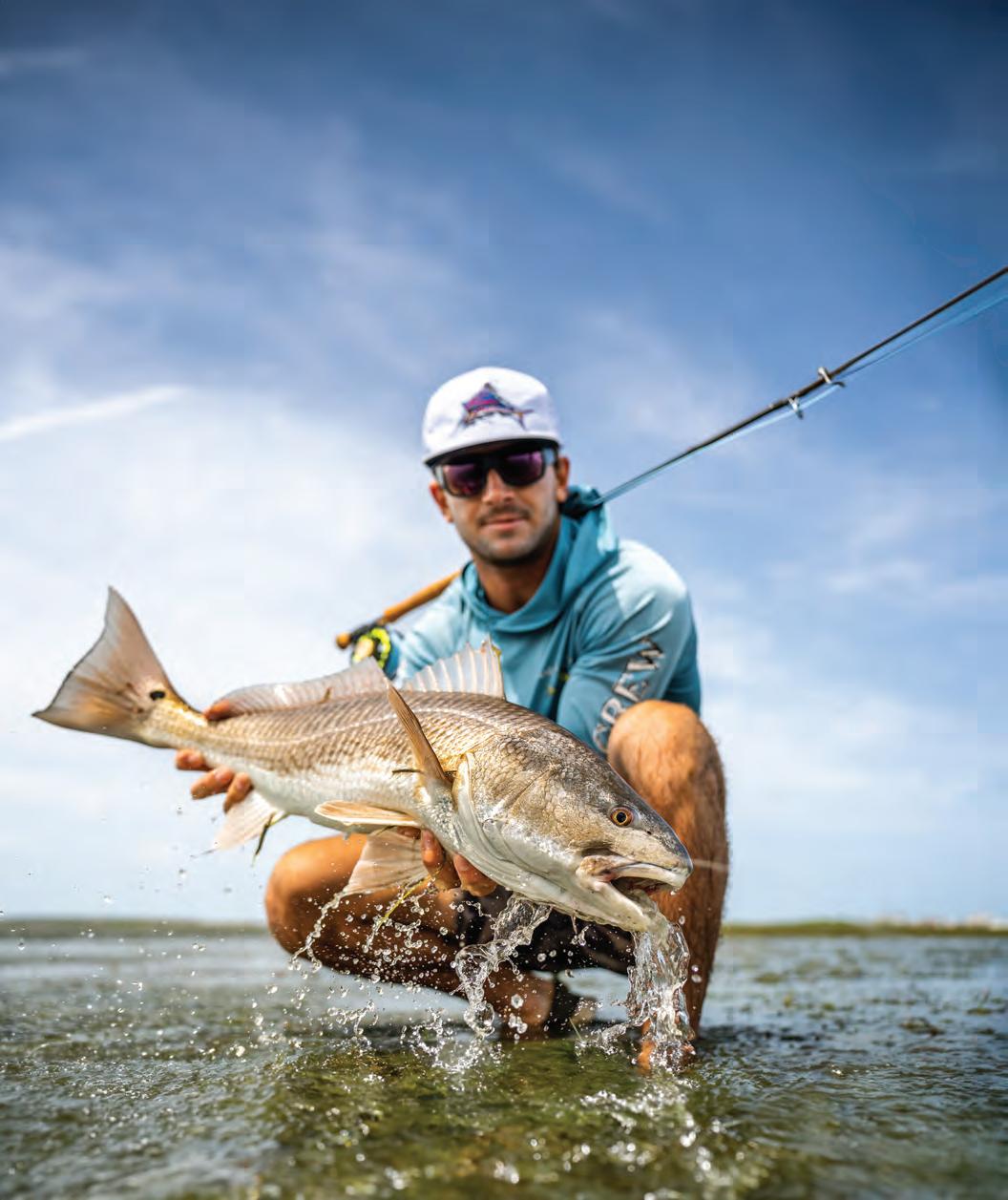

It could not be more true for the month of October, and the season for the shrimp, white shrimp to be specifc. Te (white) shrimp will start to “march” from the sounds towards the inlets and into the ocean. Tey will do this march against the current towards the ocean at night mainly. Tis is the very reason we fsh and catch shrimp at night. With the new LED lights, you can produce hundreds and even thousands of lumens with very low wattage/battery drain.
Do your own research, but I’ve found the Illumisea brand to be cost efective and super bright. When you fre up the lights, you will attract the shrimp. When you have the shrimp, you have the fsh. Pretty simple concept. I’m not saying the fsh will not eat mullets, menhaden, cigar minnows and sardines, or whatever is prevalent in your location, but what I am saying is they will key in on the shrimp and become pretty darn picky if there are a lot of shrimp present. Tey don’t have to be huge shrimp,


just a shrimp. I have seen really nice trout eating (keying on) the very small ones at times. If you can fnd the large 15-18 count then you’re good to go for whatever you want to catch. We call these “Tarpon Selects”. Everything in the water will eat these, from the average sized trout and drum to the largest snook and tarpon. Period. It’s the king of all baits, and October is the month to make the most of it.
For more information, visit barefootcatsandtackle.com and check out his YouTube channel.





brooks@coastalanglermagazine.com



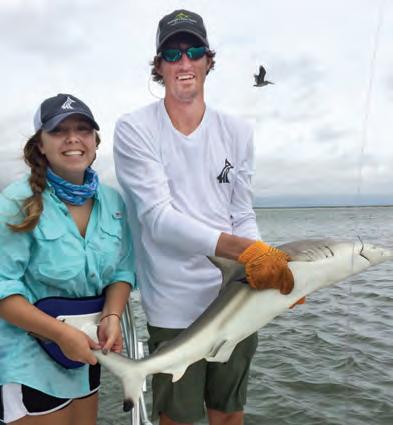

by Capt. Mike Able, Contributing Writer
Don’t worry this isn’t supposed to be a downer fishing report. In fact, it’s the complete opposite. When the days start getting shorter and the temperatures start cooling, it means several things for the outdoor enthusiasts! Typically, college football has started, deer season opens up, and the fishing starts to shape up to hopefully be the best of the year!
For me, I focus on fishing and watching a little bit of football (when I’m not fishing). As the air temperature drops the water temperature follows suit. When that happens, migratory species such as bluefish, ladyfish, tarpon, sharks, as well as baitfish start moving south. When water temps get into the low 80s and high 70s you can bet that the migration of fish and bait will soon begin. You will typically see more of a wind from the northeast direction that brings the cooler air. Large schools of “horse” mullet make their way down the beaches and allows for easy targets for tarpon, sharks and big redfish!
The best way to target bull redfish, sharks, and tarpon would be getting setup in an inlet, around a jetty, or even maintaining a positioning around those schools of bait as they move down the beach. Matching the hatch is always a preferred method! I have had some extremely good bull redfish days with live mullet rigged on the bottom around structure. A short sixty-to-eighty-pound leader rigged with a seven to eight ought circle hook is my go-to. I rig a sinker slide in a fixed position with a four-ounce bank sinker. You will need to adjust weight based on current and depth. No such thing as too heavy of a weight. You can also fish free-lined mullet on the edges of bait schools for tarpon and sharks. This time of year, a lot of your larger sharks show up like blacktips and spinner sharks that can provide awesome airborne action too! While water temperature will be the deciding factor on when the inlets and jetty bite slows down for migratory species, it typically falls around the mid to late November time frame.
When the beach and jetty fishing slows, it is time for the creek bite to shine. By this time of year water temperatures are in the mid sixties and it’s a numbers game at this point. You catch a fish in an area, you will likely catch many more. Now on to the juicy part of fishing this time of year! Yes, you can use live and cut bait but what you should really focus on is your artificial game. If there is a time of year to practice fishing artificial baits it’s definitely now! Start with something easy like a DOA, Vudu, or Z-Man shrimp rigged three feet under a popping cork. Use twenty-pound leader to connect the shrimp and float. Work it aggressively along the grass edge with a hard pop of the rod tip to make the shrimp rise in the water column. Give it time to descend, as that Is likely when you will get the bite. The new Z-Man Prawn Star shrimp is a must try, with its lifelike body and action. One of the biggest things I would pay attention to is water clarity. When the water is stained use a darker color and if it is clear use a more translucent color bait. When the true cold sets it it’s time to take off the float, fish a little deeper and slower but that’s not until at least December!

Until then, check out our website and social media for upcoming seminars and events! We love to share our knowledge and passion for fishing and hunting the Lowcountry so stop on by and ask an expert or watch some of our instructional videos on the website! haddrellspoint.com
Tight Lines,
Capt Mike Able
Haddrell’s Point Tackle & Supply • Since 1983 843-881-3644(Mt Pleasant) • 843-573-3474(West Ashley)



by Capt. Justin Ravenel, Contributing Writer
Wow I can’t believe that summer is over and it’s already getting chilly in the mornings. Pretty soon the water will begin cooling off as well and that means the fishing is about to be incredible for the next six months.
Fly fishing in the Lowcountry is primarily based around red fish. Of course we have other saltwater species willing to eat feathers, such as Trout, Tripletail, Bluefish, Jacks, Cobia and Spanish but the real meat and potatoes in the Fly scene are Redfish. If you happen to be into the “obsession with failure” of fly fishing in the Lowcountry then you most likely prefer one of two ways of doing it. Flood tide fishing for tailing Reds in the warmer months or Lowtide schools of reds in the cooler months.
Don’t get me wrong; both of these avenues are fun as hell and they both revolve around the core aspect of how it’s achieved which is “sight fishing”. Sight fishing is exactly how it sounds. Instead of casting a conventional bait blindly over and over or soaking live or cut bait and waiting for a strike; you instead look for the fish before you cast. This is one of the core aspects of fly fishing because it delicately blends the sport of hunting and fishing together. There are many other aspects to why fly angling is a more enlightening experience but there is something about seeing, stalking and then presenting a fly to a fish that just can’t be understood by reading this article.
Winter time is my preference for a few different reasons but primarily because of the privacy. Something about an endless winding little creek with 6 foot of mud and Spartina going up on either side of me is just so grounding in regards to a proper trip into Nature. Knowing that just around the corner there are reds, noisily busting bait up and down the bank. Then you finally pole your skiff up far enough to see and there are 30-40, big reds moving together like a pack of wolves in 10 inches of water. Your heart will start thundering in your ears as you do your best to get ready for the cast without making any noise. They all suddenly turn and are heading in your direction, looking for their next victim. All you have to do now is not mess up! If that fly lands anywhere within a foot of them you’ll see a red immediately break off from the pack and dart straight for it. Next you see the moment that fish decides to hone in like a ballistic missile and hit the target. After the gill flair and the outstanding sound of that slurping pop; you’re on! Next, it breaks back for the school but before its friends realize what’s happening; they get fired up as well and start darting all around him to see what he ate. As you reel it closer you get to see 3-4 of its buddies following along; worried they won’t get in on the action!
All that activity is hard to hate and the only reason summer Flood tides take a close second in my heart is because in the winter; all of that experience was hidden by the high bank on either side of you. So no passer byers or leisure boaters get in on the thrills as well.
What I’m trying to say plainly is, we owe it to the fish around here to not advertise where they live and thrive. Sure you may have the best intentions but one of the three spectators watching you may not so why take the chance.
With that said, there are plenty of flats to catch tailing reds that are serene and private and I enjoy fishing them on the flood tides. I just prefer winter scene.
Captain Justin Ravenel
Ravenel Fishing Charters
843-864-5056
Facebook: ravenelfishingcharters.com
Instagram: @justin_ravenel


by Noah O’Brien, Contributing Writer
ith October, comes the best time to fish for all Charleston anglers. At the Folly Beach Pier, we see the full spectrum of species to catch in the shallow Atlantic waters. You’ll see an abundance of red drum, king mackerel, Spanish mackerel, and sheepshead in the deeper water towards/ off the end of the diamond. With black drum, speckled trout, sheepshead, red drum, and sheepshead all being caught in the surf. All species have their preferred baits and methods to be caught, but a simple Carolina or 2-drop rig on the pilings or right in the surf will give you the best chance of catching something you’ll like. We are going to discuss red fishing, as this is the month where we will typically see 40-60 bull reds being caught on any given day in the right conditions.
As many anglers up and down the Carolina coast know, October is the peak red fishing month. With the cooler weather slowly coming in, a lot of the migratory species that make their homes in the North or in deeper Atlantic waters will start coming south and inshore to start hunkering down for the winter months. With the current projected storm season in the Southeast, this will create the perfect conditions for those bull reds that everybody goes in a frenzy for. To catch these massive reds, you will want a heavier rod along with 60lb leader to ensure you do not lose your catch. A simple dropper rig with a 4-5 ounce sinker, a circle hook above a 3/0, and chunked mullet or really any smaller bait fish will almost always do the job. While we understand that having larger hooks and bait increases your chances, we have strict rules that allow hooks up to a 4/0 and bait sizes up to 2x2x2 inches, so please catch yourself up with all pier rules and follow them appropriately, or you could be asked to leave the premises.
Please come out to the annual Holiday Festival of Lights which is hosted at the James Island County Park! If you have young ones, or want to get into the Holiday spirit, this is the perfect place to do it! The Holiday Festival of Lights will run from November 15- December 31, so you have plenty of time to make it. We always encourage our guests to come on weekdays, as this will help you avoid traffic on the busy weekends and holiday weeks.


Noah O’Brien, Operations Manager II Folly Beach Pier 101 E Arctic Ave, Folly Beach, SC 29439 Office: 843-762-9516 / Mobile: 843-814-7344
Noah O’Brien@ccprc.com / ccprc.com


By Noah Corcoran
The Marine Detailing Revolution: Why SiO2 is a Game-Changer
Maintaining your boat's shine and protection is a constant battle against nature’s elements—UV rays, saltwater, and environmental contaminants can all take a toll. At Marine Detail Supply Charleston, we recommend SiO2-based products as the gold standard in marine detailing.
SiO2, or silicon dioxide, is the powerhouse behind ceramic coatings. These products create a robust, hydrophobic layer that repels water, dirt, and grime, keeping your boat cleaner longer and making maintenance a breeze. More importantly, SiO2 forms a durable barrier against oxidation and UV damage, which helps preserve the boat's gel coat and paint, ensuring it stays vibrant and protected against fading.
- Starke Replenish: This versatile detail spray is perfect for restoring and enhancing your boat's existing protection. It revitalizes the hydrophobic properties of ceramic coatings, ensuring water beads off effortlessly, while delivering a deep, glossy finish. Easy to apply on gel coat, paint, and metal, Starke Replenish is an essential tool for maintaining that just-detailed look.
- Gtechniq Fast Coat: Ideal for boaters who want quick, effective results, Gtechniq Fast Coat offers a high-gloss finish with long-lasting protection. Its user-friendly application makes it a favorite for those short on time but unwilling to compromise on quality. With strong UV protection, it keeps your boat’s colors vibrant and shields against environmental damage.
- Starke Ceramic Coatings (Repel Pro + Liquid Thor): For ultimate durability, Starke Ceramic Coatings are the go-to choice. These coatings bond permanently to your boat's surface, forming a hard, glass-like shield that stands up to the toughest marine environments. They offer unmatched resistance to UV rays, saltwater, and other contaminants, drastically reducing maintenance and preserving your boat's appearance for years.
SiO2-based products are revolutionizing marine detailing. Whether you're looking for quick maintenance with Starke Replenish or long-term protection with Starke Ceramic Coatings, these products offer the ultimate defense against the elements. Marine Detail Supply Charleston stands by these advanced solutions to help keep your boat in top shape, ready to shine on the water.

For a number of years now, a number of my fans have requested that they would like to see an article on fishing etiquette and recently I have decided to do just that. So let’s start by asking, “What is the definition of etiquette?” The definition that most applies out of the three that are applicable is “the customary behavior of members of a profession, business, law, or sport towards each other.” Fishing is a sport, and believe it or not, there is a customary behavior that should be used between fishermen. Some would even say common sense, but that could be stretched because it would depend on what is common to the individual.
Personally I have fished in locations where the locals spent the day swearing at each other, fighting, arguing, etc. That is not the common behavior that myself and others were brought up using. Of course, there are times when one can lose control if being provoked but that would not be considered a common behavior. Fishing etiquette is really quite simple, even though fishing is a competitive sport, and every fisherman would love to out-fish all the others around them, so let’s talk about examples of fishing etiquette.
The first statement that comes to mind as I begin is—treat others as you would like to be treated. If you are fishing in one spot and casting straight out catching fish, you sure would not want anyone setting right up against you and casting right over your fishing line. So etiquette would tell you not to go over to someone else’s spot and cast in it while they are fishing, and even if you are standing at a distance or boating at a distance, you would make sure that you would not cast into their casting zone. What I mean by zone is the radius they have set up around their boat or spot to catch fish. The etiquette has always been to pay your respect and either fish somewhere else or close by as long as you are giving them the proper space and fishing your own spot or zone.
by Jiggin’ Jerry, Contributing Writer
Sport fishing also brings us to a lot of public locations, and when in public locations, you will be fishing around other people, either fishing or not fishing. Some individuals find themselves completely ignoring others around them and behaving as if they are by themselves or on their own private property. For example, screaming, yelling, using profanity, playing loud music of their choice, almost to the point that someone could say they are disturbing the peace, and in fact, they are. That type of behavior is meant for private locations or public property that allows it. Not all public properties allow that type of activity, and individuals should check out the rules and regulations of the fishing piers, docks, parks and other locations before going on an outing. This will help keep confrontations down to a minimum. When it comes to sport fishermen using boats versus recreational boaters, there seems to be a battle on the water. When a boater is stopped and anchored and either fishing or resting, the etiquette would be when passing to slow down and pass at a safe distance, trying not to thrash the other boater in your wake. Not doing so could be dangerous to other boaters, especially if the other boat is a small boat, kayak, canoe, etc. I have experienced and seen other boats rolled over or individuals tossed off of their boat due to reckless boaters with no etiquette. When it comes to two different boaters fishing in the same vicinity, professional etiquette is required. The rule of the water has always been first come, first serve. If a boat has beat you to a spot, then be professional and kind and let them fish the spot. The same way you would like to be treated if you had arrived at that fishing location first, and if there is room for another boat to fish at that location, please be professional and courteous and create a safe distance with the boat and your fishing lines in order to be able to fish without inconveniencing or interrupting the other sport fisherman.

An etiquette has developed between sport fishermen over many years. Most sport fishermen treat each other with respect and kindness. It is one of the reasons why I love the sport. While on my fishing excursions, I have witnessed generosity, fishermen helping each other with bait, giving each other hooks, weights, fishing line, netting for each other, and have never met each other before. One fisherman just excited watching the other fisherman land a beautiful game fish. It is a sport that allows everyone to play. It is a sport that requires respect and etiquette. Now the fun part, when it comes to fishing in public, we all know or have just learned we all require respect and etiquette between fishermen, but there are individuals in public that do not fish, and we fishermen run into them all the time. Some are even hostile. Sometimes you find yourself being harassed, being called names, your bait being grabbed from you and thrown back into the water. I’ve even seen individuals take a fisherman’s catch and throw it into the water. I’ve seen them grab railings and stand in front of them and try to block them from fishing. I’ve even seen them pull up on boats blocking fishermen from being able to engage in the sport. Unfortunately, no matter how hard we try, etiquette has not found its way to some of those individuals that seem to have a dislike to sport fishermen. But I would like to help make you aware of some information that could aid you if you ever experience any of the harassment I have mentioned above.
S.C. Code Ann. § 50-1-137: It is unlawful for a person wilfully to impede or obstruct another person from lawfully hunting, trapping, fishing or harvesting marine species. Any person violating the provisions of this section is guilty of a misdemeanor and, upon conviction, must be punished as provided by Section 50-1-130. In addition to the criminal penalty, any person convicted must have his privilege to hunt, trap, fish or harvest marine species recreationally or commercially revoked for one year.
This South Carolina law applies to anyone, including other fishermen, if they impede or obstruct you while you are sport fishing. You have the legal right to call law enforcement and press charges pursuant to S.C. Code Ann. § 50-1-137 if you find it necessary to do so. This is just in case you thought you had no rights. As a licensed fisherman, you do.
I hope this helps all of you with your next fishing adventure.
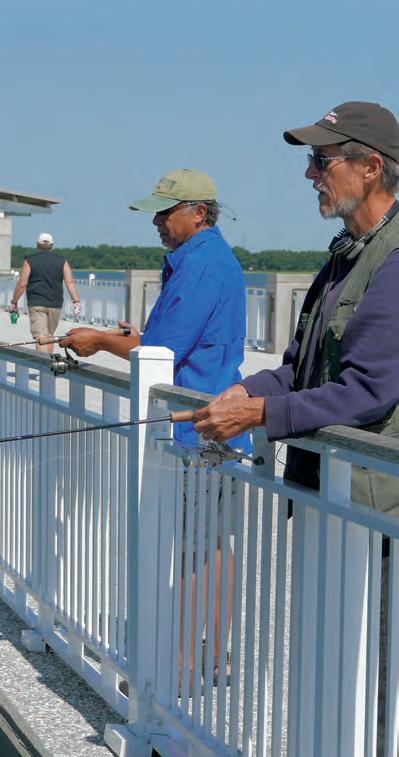


by Chris Pounder, Contributing Writer
ctober may be the best month of the year for fishing at the Mount Pleasant Pier. As the water starts to cool, it signals the dinner bell for a variety of species to start eating for winter. Be ready for those first few evenings where temps are brisk and plan to bend a rod the following morning. You’ll want to have some live mullet, shrimp, or minnows with you for bait. You can get away with throwing artificials resembling these baits as well, but this time of year I’d recommend live bait if you can find it.
Historically, some of the best flounder caught from the pier have come in October and into November. It’s not out of the question to see 4-5 pounders when conditions are right. Using a Carolina rig, anglers have a lot of success “walking the dog” along the pier railing. To do so, drop your rig over the side till the weight rests on the bottom and tighten up the slack in your line. Let the bait rest for a few seconds before raising the rod so the bait is off the bottom and moving along the rail a step or two and drop down again. Flounder are ambush feeders and this will allow you to cover more ground and may just get the attention of the doormat you’ve been looking for. You can also just drop the rig over the side, pull up a chair, and enjoy the harbor breeze while the bait gets a workout down below.
Saturday, October 26 will be the last Cast-Off Fishing Tournament till 2024. Tournament runs from 7am – 2pm and entry is just $5 plus the daily fishing fee. Registration is available on site and will begin just before the 7am start time. Prizes will be awarded to the 1st, 2nd, and 3rd biggest
fish, best youth catch, and best aggregate weight of 5 fish. We hope to see you on the pier in October.


For any additional information about the pier or what’s biting this week feel free to call the River Watch Cafe & Gift Shop on the pier at 843-762-9946
Chris Pounder, CPRP Manager • Mount Pleasant Pier


















By Katie Jo, Pluff Mud Princess Outdoors
If you traveled 20 hours internationally, with two layovers from your home in the Czech Republic, to attend a friend's wedding in the United States—specifically in Charleston, SC—for just one weekend… would your first thought be to connect with strangers on a local Charleston fishing page?
This is exactly how I met my new friend, Jonas Eder from Prague. While scrolling through my Facebook feed in early September, I stumbled upon his post that said something like, “Hey everyone, this might be a long shot, but I’m hoping to find an opportunity to go fishing while I’m in your area. I’d be so grateful, even to just cast a line. And if you ever come to Europe, I’d gladly return the favor.”

Initially, I thought, “There’s no way I can take a random guy from the Czech Republic out fishing; that’s how murder documentaries start.” However, after noticing some typical, dismissive responses from others in the community, I considered, “What’s the worst that could happen?”
As Jonas reached out and we exchanged a few messages about when, where, and how I could take him fishing, I wondered, “Am I crazy? What if we can’t even communicate? I don’t speak Czech.” But then I reminded myself that fishing is a universal language, and I didn’t need to share a common language to enjoy a remarkable experience on the water. The thrill of feeling your rod bend with a fish is something that transcends language.
When the morning of our fishing trip arrived, and I launched the kayaks on the captivating yet tricky Wando River, I knew this would be an unforgettable adventure. As I set Jonas up in his pedal-drive kayak that day, I made sure to explain everything thoroughly. I wanted this trip to be more than just a once-in-a-lifetime opportunity; I aimed for it to be an experience he would cherish, complete with skills

MT. PLEASANT
Mt. Pleasant Pier Pitt St. Bridge
FOLLY BEACH
Folly Beach Pier Folly River Park
JAMES ISLAND Bowens Island Sol Legare Sunset/Demetre Park
WEST ASHLEY
Higgins Pier
West Ashley Greenway
West Ashley Park Northbridge Park
DOWNTOWN
Waterfront Park Pier
Colonial Lake
Alberta Sottile Lake Brittlebank Park






and memories. I discussed the fishing rods—both 7’2" medium-fast rods with 3000 series reels—along with the rigs I had prepared for him, including the reliable Carolina rig, 20 lb fluorocarbon tied to braid, a small split shot, and a 2/0 circle hook. I also explained our extreme tidal exchanges and how the tides shift every six hours, a unique feature of our area. I highlighted that the best time to catch inshore species like Redfish, Trout, and Flounder is during the 2–3-hour window before and after low tide, and we would focus on structures like oysters, docks, and downed trees as great fishing spots.
As we navigated back into the winding Lowcountry creek, I not only showed Jonas how to catch live bait like mullet and shrimp but also assured him we would catch that Redfish he had traveled thousands of miles for. Thankfully, Jonas spoke English, so everything was easily understood.
From the moment his rod bent to the last catch in the pouring rain, we shared an incredible trip of a lifetime. Jonas managed to catch multiple redfish, flounder, and even some trout for an inshore slam, and he even caught a tagged SCDNR redfish—an impressive feat for a first-time Lowcountry angler.
This experience exemplifies how universal and impactful fishing can be. Trying new things might be daunting, but they can also create unforgettable memories. No matter your background, the language you speak, or where you come from… just go fishing; you’ll be glad you did.





Coastal SC FCA Fishing with SALTT is coming to the Lowcountry this school year with youth redfish tournaments.
You do NOT have to have a team or club at your school so just sign up and fish the events.
Competition boat tourneys will be in the fall and spring from the Ashley River in Charleston and The Sands in Port Royal for students in grades 1-12.
register > virtual check in video the morning of > bring in your fish for weigh ins
We plan to have food, a devotional and so many prizes. Gift cards for the winners plus a grab table for everyone to take home some fishing tackle.


October 7
Free Surf Fishing Seminar
Haddrell’s Point Tackle @ 6:00 RSVP @ 843-881-3544
October 12
Palmetto Society
Redfish Tournament
Register at Eventbrite Virtual Captain’s Meeting Oct. 6-7pm
October 12
Folly Beach Pier
Cast Off Tournament
7am-2pm.. More info at 843-762-9516
October 12
2nd Annual CPR Fall Tournament
Sea Sea’s Honey Hole • 901 8th St. Port Royal, SC *Inshore slam tournament
October 14
Free Inshore Fishing Seminar
Haddrell’s Point Tackle @ 6:00 RSVP @ 843-881-3644
October 26
Mt. Pleasant Pier
Cast Off Tournament
7am-2pm.. More info at 843-762-9946
January 24-26
Charleston Boat Show
Charleston Area Convention Center Details @ Charlestonboatshow.com Submit
brooks@coastalanglermagazine.com





The catch was hot toward the end of summer at Folly Pier with a large Jack and fine trout. (Photos submitted by Folly Pier)

Pluff Mud Princess and Jonas with a fine small trout to round out the “inshore slam” on a recent guide trip

Late summer success from Haddrell’s Point. (Photos submitted)









Fall fshing ofers anglers a perfect blend of cooler weather, stunning scenery, and active fsh. As summer fades, the changing conditions in freshwater and saltwater environments create ideal opportunities to catch a variety of species. Whether in lakes, rivers, or coastal waters, autumn provides some of the most rewarding experiences for fshing enthusiasts.
One reason fall is excellent for fshing is the behavior of fsh during this season. As water temperatures drop, fsh become more active, feeding aggressively to prepare for winter. In freshwater, species like bass, trout, and walleye move into shallower waters, making them easier to target. Bass, in particular, hunt more during the fall, feeding on schools of baitfsh in cooler, oxygen-rich waters.
Largemouth and smallmouth bass gravitate toward areas with abundant food sources. Anglers ofen succeed using lures that mimic baitfsh like shad and minnows. Crankbaits, jerkbaits, and sof plastics, especially in natural prey colors, are popular choices. Fishing near structures like submerged logs, rock piles, and weed beds can increase your chances of landing a big one, as bass ofen use these areas as ambush points.
Trout fshing also peaks in the fall, with cooler water temperatures bringing these fsh into more accessible parts of rivers and streams. Fly fshing is particularly efective during this time, as trout are more likely to strike at dry fies and nymphs resembling the insects they feed on. In many regions, fall is also the time for spawning runs, particularly for salmon and steelhead, ofering anglers a chance to catch them in large numbers amid stunning autumn scenery.
In saltwater, fall is synonymous with the migration of popular species like striped bass, bluefsh, and redfsh. As these fsh move along coastlines, following baitfsh like mullet and menhaden, they ofer exciting opportunities for surf and boat fshing. Te fall mullet run is a
I’ve spoken with and interviewed many anglers during my career as an outdoor writer. One of my favorite questions is, “Do you remember the frst fsh that you caught?” It’s amazing to me how many anglers do in fact remember the very frst fsh that they ever caught. Most recall every element involved in that frst catch. All seem to instinctively smile when recounting the event. It’s a fond memory, one that glistens each time it’s retold.
Tis right of passage can occur at any age. For me I was four years old standing beside a small pond with a cane pole, red and white bobber and baited hook in the water, with my dad kneeling beside me. I remember that it was a sunny day and that we were both smiling.
As the bobber went under my dad said, “Catch him, Son!” and I instinctively raised the cane pole to bring the brim to my dad’s reach. We put the fsh in a metal bucket full of water and I stared at it and observed it the entire ride home. I remember how proud my dad was as he shared the story of my catch with the rest of our family, and thus began a lifetime of catches and smiles and fond memories and a sense of pride and accomplishment. A lifetime of those wonderful elements thanks to my dad.
Teach a kid to fsh. Tey’ll likely never forget you, and you’ll likely change their life for the better.

highlight for many saltwater anglers, drawing large predatory fsh close to shore where they can be targeted from the beach or pier.
For those targeting striped bass, the cooler fall waters bring these fsh into the shallows, making them more accessible to surfcasters and inshore anglers. Live bait like eels or bunker is ofen the go-to choice, but lures like topwater plugs, sof plastics, and bucktails can also be efective. Te sight of a striper smashing a surface lure in the crisp autumn air is an experience that keeps many anglers coming back year afer year.
Another advantage of fall fshing is the relative solitude. With many focused on hunting or other seasonal activities, fshing spots are less crowded than during the summer. Tis allows for a more peaceful experience, where you can fully immerse yourself in nature. Te vibrant fall foliage, combined with the quieter atmosphere, creates a perfect backdrop for a day of fshing.
Overall, fall fshing ofers something for every angler. Whether chasing bass in a quiet lake, casting for trout in a mountain stream, or battling gamefsh along the coast, fall provides unparalleled opportunities to connect with nature and enjoy the thrill of the catch.
By John Mosley





Relentless performance for every yacht, everywhere, every time. It is so much more than just bottom paint.












Interlux’s range of fouling control products not only improves your performance by protecting your hull from fouling, they also protect against the spread of invasive species, safeguarding your local waters when exploring new regions, therefore helping you make a difference by looking after the waters that have provided you with enjoyment and freedom for so many years.
Like you, we have a passion for boating. We provide boaters the hull protection they deserve with over 140 years of cutting-edge science, technology and expertise. You can expect only the best from every Interlux yacht paint product, providing you the confidence to explore your world.
Early morning fog and dropping water temperatures are a sure sign fall is near.

Yes, it’s that time of year when the big sheepshead and cool water redfsh invade the local deep-water docks and structures. Both species are tough opponents, challenging even the most skilled anglers.
Sheepshead are most likely to be found around docks where subsurface pilings are covered in marine growth like oysters and limpets, and where tiny crabs live inside. Extreme submerged structures such as rock outcrops or limestone ledges are good too.
Tis time of year, seek the larger redfsh around deep water docks where white bait and pinfsh congregate for protection, becoming a plentiful quarry. Both reds and sheepsheads like to use the current that brings food naturally in their direction, possibly using the pilings as an ambush point from which to launch their attack. Look in the proximity of extended dock systems and/or rough shoreline structure; lots of the bigger fsh are caught here.
Tiny crabs or sand feas will produce great sheepshead action. Live shrimp cut in half are my next “go to” bait. Seek docks with at least eight feet of water (10’ to 14’ is ideal). Cast to the base of the pilings. Ten tighten the line to feel the bite.
Small freelined pinfsh or live whitebait are great for reds as the water cools thru early October.
My neighbor Jerry claims, “Redfsh hate pinfsh. Tat’s why they are such good bait.”



By CAM Staf
Anglers have long observed that fsh activity is infuenced by the lunar cycle, giving rise to what are now known as lunar tables. Tese tables serve as invaluable tools for predicting when fsh are most likely to be active and feeding. But how do lunar phases afect fshing, and how can anglers use lunar tables to their advantage?
A lunar table provides information on the moon’s phase and its position relative to the Earth and the sun. Tese factors signifcantly afect tides, which in turn infuence fsh behavior, especially in coastal and tidal waters. Te moon’s gravitational pull creates tides, and as the water moves, it stirs up nutrients and prey, encouraging fsh to feed.
Beyond tides, fsh have a circadian rhythm that governs their daily activities, including eating and resting. Many species, especially saltwater
“Really?” I said, “Reds hate pinfsh?”
“Yeah”, he said, “Pinfsh eat the redfsh eggs and the reds hate them.”
Now that’s some good information right there! I laughed and replied, “I did not know that!”
Oh well, to each his own.
OK, Jerry, if you say so.
I guess I’ll have to believe him because they do work well.
Cut ladyfsh tightlined on the bottom is always good.
Cooling fall waters are great for many species which include pompano, mackerel, sheepsheads, trout and reds. Find some good structure or a vacant dock and give it a go.
I wish for you a most enjoyable and productive day on the water while in pursuit of your fall quarry.
Capt. Russ Walker is a USCG Masters licensed fshing guide and owner of Tide Walker Charters out of Cape Coral, FL. www.tidewalkercharters.com.
fsh, also follow a lunar rhythm directly infuenced by the moon’s phases. Fish tend to be most active during the new moon and full moon phases, when tidal movements are more pronounced and feeding conditions improve.
1. New Moon: During the new moon, when the moon is between the Earth and the sun, strong “spring tides” occur due to the combined gravitational forces of the sun and moon. Tese heightened tides trigger more active feeding, particularly inshore and near tidal fats.
2. Full Moon: Like the new moon, the full moon also causes strong spring tides. Fish, especially predators, are more active at night during this phase, taking advantage of the increased light for hunting.
3. First and Last Quarter: Tese phases generate weaker “neap tides,” with less pronounced tidal changes. Fishing can still be productive, but fsh activity is generally reduced compared to the new and full moon phases.
Lunar or solunar tables break down the moon’s infuence into specifc time slots for optimal fshing, categorizing them into “major” and “minor” feeding periods. Major periods occur when the moon is directly overhead or underfoot, while minor periods happen when the moon is on the horizon. Major periods generally result in higher fsh activity, although both are useful for timing fshing trips.
Most lunar tables are simple to read, ofen color-coded for clarity. High fsh activity times may be highlighted in green or red, while less favorable periods might appear in blue or gray. By planning your fshing trips around these prime times, you can increase your chances of success.
However, lunar tables are just one factor among many. Weather, water temperature, and the habits of specifc fsh species also play crucial roles. For instance, overcast conditions during a full moon can reduce visibility, hindering feeding, while high winds or changing barometric pressure may alter fsh behavior.
Lunar tables are a valuable tool for anglers seeking to maximize their success. Understanding the moon’s phases and their efect on fsh behavior, especially during new and full moon phases, can help you plan fshing trips during peak activity periods. Although they don’t guarantee a catch, combining lunar tables with local knowledge and weather conditions can signifcantly enhance your chances of a productive day on the water.
Introducing kids to the sport of hunting through squirrel hunting can be an excellent way to nurture a lifelong appreciation for nature and outdoor skills. Squirrel hunting ofers a relatively safe, manageable, and rewarding experience for young hunters. Tese small game animals are abundant and found in many habitats, providing ample opportunities for success, which is crucial for keeping kids engaged.
Squirrel hunting teaches essential hunting skills such as patience, observation, and marksmanship. Because squirrels are agile and quick, young hunters learn to move quietly and hone their ability to spot subtle movements in the trees. Tese skills are foundational for all types of hunting, making squirrel hunting a great starting point.
Moreover, squirrel hunting emphasizes safety and ethics, as kids learn to handle frearms responsibly, understand hunting laws, and respect wildlife. Parents and mentors can use this experience to instill values like conservation, teaching kids about sustainable practices and the importance of preserving natural habitats.
Te physical demands of squirrel hunting are also suited for young hunters. It typically involves moderate walking and the excitement of a successful hunt is an excellent way to build a child’s



confidence and interest in the outdoors.
By Benjamin Babcock
Overall, squirrel hunting is not only a gateway to the broader world of hunting but also a meaningful way to bond with children and introduce them to the principles of responsible, ethical, and sustainable hunting practices.
Te .410 over-under shotgun is an excellent choice for a child’s frst frearm, ofering a combination of safety, versatility, and ease of use that makes it ideal for young or novice shooters. Tis type of shotgun typically has two barrels stacked one on top of the other, which gives it a balanced feel and allows for quick target acquisition, making it easier for kids to handle and shoot accurately.

One of the main advantages of a .410 shotgun is its low recoil. Te .410 is known for being a “light” shotgun, meaning it doesn’t have the heavy kick associated with larger gauges. Tis is particularly important for young shooters, as it allows them to focus on learning proper shooting techniques without the fear of painful recoil, which can discourage continued practice.

Te over-under design also emphasizes safety. With its simple break-action mechanism, it’s easy
carried safely in the open position when not in use. Additionally, the .410’s limited range and pellet spread make it a good learning tool, encouraging kids to develop accuracy and precision.
Te versatility of the .410 makes it suitable for various types of hunting, from small game like squirrels and rabbits to clay target shooting. As a child’s skills and confdence grow, the .410 over-under shotgun can serve as a reliable and consistent companion, helping them build a strong foundation in shooting sports. Overall, it’s an excellent starter gun that balances ease of use with the challenge necessary to develop profciency.




By Capt. Quinlyn Haddon

Throughout the month of October, the fishery in The Florida Keys will begin its autumn transition. This midway point between the drastic change of summer and winter fishing, can be unpredictable to forecast, but also provides exciting surprises during this overlap.
With cooler waters driving fish nearer to shore, reef and backcountry fishing will become more and more productive as we push into our winter fishery. The bait fish that particularly favor our shallower waters as the temperatures drop, will bring with them some of our favorite winter predators. Depending on the timeline of this seasonal change, we may begin to experience the return of sailfish and wahoo near our reef.
The anticipated temperature change of the water not only drives fish closer to shore, but is also a massive trigger for southbound migration. This is especially true for one of the ocean’s most notable vagrant; the swordfish. Fully understanding the habits of a fish that can migrate hundreds of feet up and down the water column each day, and thousands of miles each year,
can be a challenging endeavor. However, the data that has been collected on swordfish to date, has proven to be reasonably consistent.
The majority of mature swordfish, and particularly large breeding females, have been observed to spawn predominantly in the spring and summer. They favor warm waters with heavy currents for this process, which takes them as far south as the Caribbean sea. After abandoning their millions of eggs to the currents, they will begin an incredible migration in search of feeding grounds to sustain them repeating the process all over again.
Traveling thousands of miles up the coast, as far as Newfoundland, Canada, they seemingly utilize the continental shelf has a highway.
After gorging in these northern waters throughout the summer and early autumn, they then begin their return migration through our section of the swordfish highway, opportunistically feeding along the way.
While every month in the Florida Keys provides excellent opportunity to catch swordfish, this month gives us an extra bump on prevalence of larger swordfish migrating through our waters. The same is true for November as well, but with more chances of tackling windier days, October offers a more reliable forecast.
Catching swordfish is a great way to fill the box with a significant amount of quality meat. The yield of a single fish is more than enough to fill both your refrigerator, and when properly sealed, your freezer too. The unique flavor and texture of swordsteaks is sought after on its own, but there is always a chance that your catch is concealing an upgrade. In very rare instances, a swordfish’s meat will appear orange in color as opposed to the standard white. The quality of this meat is unparalleled, and is caused by the fish’s penchant for munching on shrimp. These special upgraded fish are referred to as pumpkin swordfish. How perfectly festive it would be to carve one of these this month.
The Florida Keys not only boasts an excellent fishery for swordfish, but can also get you there in about a 30 mile run offshore. This gives you a chance at a fish at a lifetime in half the time and cost of a west-coast grouper trip.
If this fish is on your bucket list, October in the Florida Keys presents a great opportunity to add that checkmark.
Capt. Quinlyn Haddon guides with Sweet E’nuf Charters out of Marathon, Florida Keys. Contact her at (504) 920-6342 or Captainquinlyn.com. Find her on social @captainquinlyn.







If your device has an LCD that has faded over time, or want to inquire about possible repair options for your unit, give us a call or visit our website!











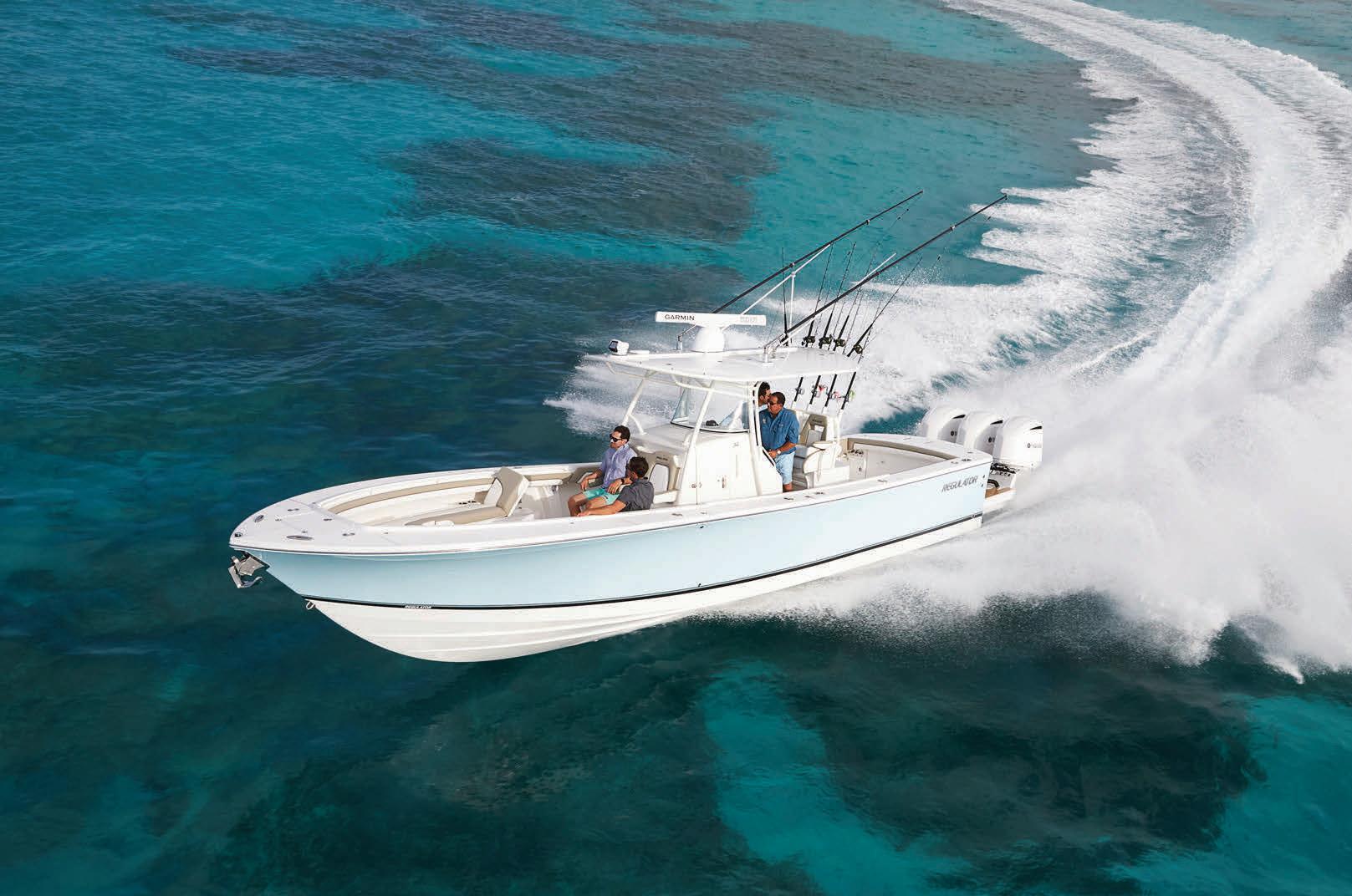
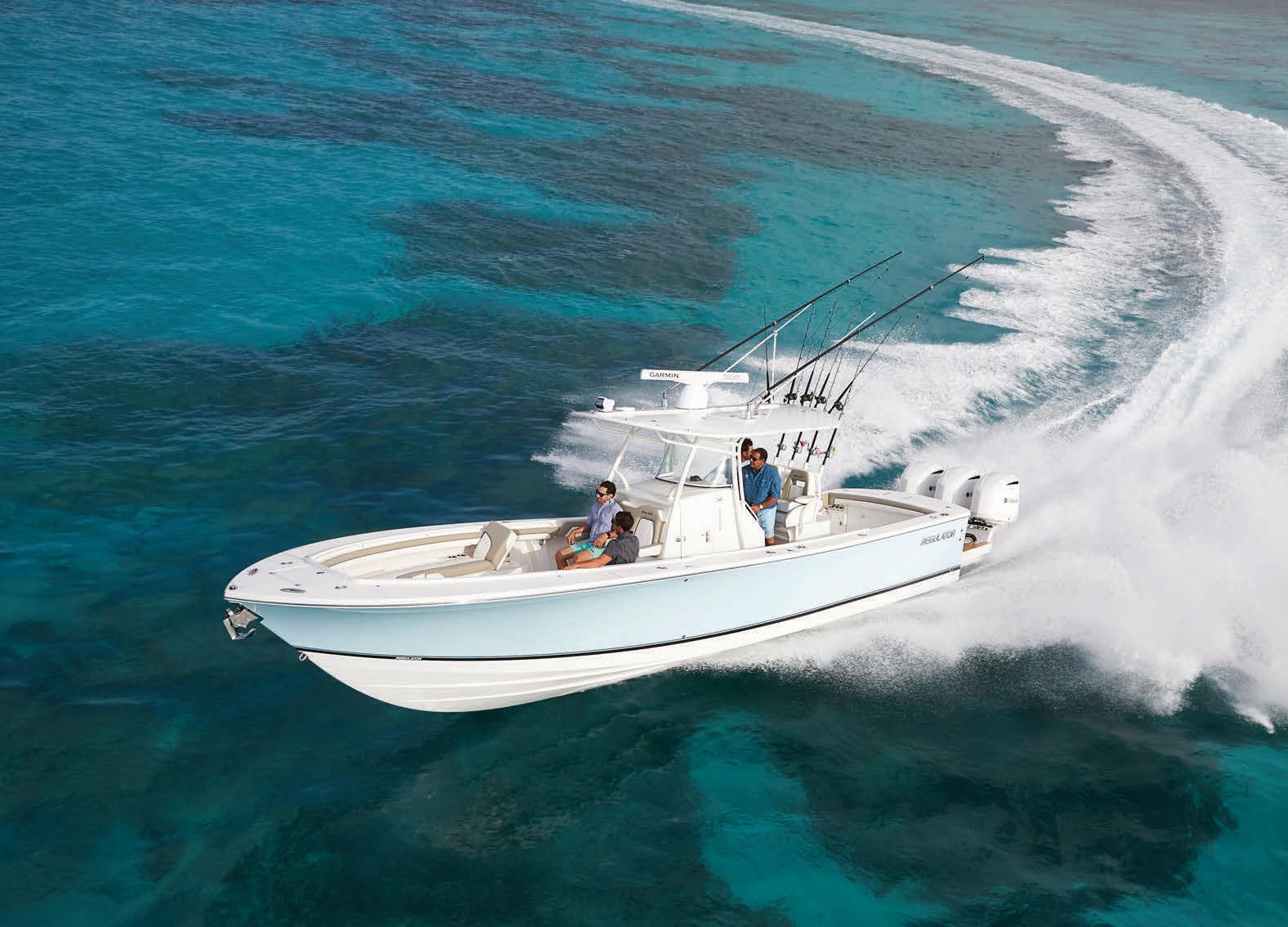



Boat Fix, a recreational boating telematics company that provides a combination of real time remote monitoring, GPS tracking, sophisticated geofencing, and 24/7 live customer support, announced today its Admiral Club Member sponsorship of the National Safe Boating Council (NSBC).
“At Boat Fix, safety is in our DNA and our goal is to promote safe, secure, and stress-free boating,” said Steve Pitsos, CEO, Boat Fix. “To support the NSBC at this level aligns with this vision. We are excited to be a part of the organization and thrilled to help them in their mission of advocating for a safer boating culture.”

“We are very grateful for the support of companies like Boat Fix,” said Peg Phillips, Executive Director, National Safe Boating Council. “Promoting safe boating takes constant education and outreach to the boating community. Only through the support of like-minded companies can we accomplish this vital mission.”
Boat Fix is more than a feet management and monitoring solution. As a tool for safer boating and boat ownership, the Boat Fix app sends real
time weather alerts and small craf advisories including wave height, visibility, and wind speeds based on the boat’s location; ofers geofence protection; safety checklists of U.S. Coast Guard required equipment including calendar reminders with fre extinguishers and fare expiration dates and helps ensure that the correct number of life jackets are on board to be worn; pre- and postdeparture checklists to help verify all systems are functioning properly; as well as remote


monitoring of battery voltage – including ultra-low, low- and high-voltage which is critical for preventing degradation of battery life and avoiding potential fres or explosions. In addition, the Boat Fix app provides advanced navigation with NOAA charts with detailed navigation marks and depths, rather than industrystandard Google Earth maps.
Users of the Boat Fix Pro app can communicate with the 24/7 Boat Fix team at the touch of a button, through voice, text, email, or two-way video chat to answer questions and diagnose issues on the water. Every call is answered in seconds, in person, by trained professionals ready and willing to help. Te industry-exclusive 24/7 Emergency Mechanical Helpline ensures boaters have immediate mechanical assistance over the phone if issues occur on the water. Te 24/7 Boat Fix Control Center also monitors unauthorized use and boat-thef prevention and can share your boat’s exact location with law enforcement.
Founded in 1958, the National Safe Boating Council serves as a national catalyst for developing a safe boating culture by providing educational resources, outreach programming, and training opportunities for industry partners and the boating community to infuence fun, safe, and responsible boating.
By Tracy Patterson

In the last decade, fshing has seen a signifcant transformation with the rise of female anglers. Once a male-dominated activity, more women are now not only participating but also excelling, reshaping the fshing community and breaking down stereotypes.
According to the Recreational Boating & Fishing Foundation (RBFF), the number of female anglers in the U.S. has increased by nearly 20% over the past ten years. In 2020, around 17 million women fshed, making up nearly 40% of all anglers. Tis shif refects broader changes in societal attitudes toward women in traditionally male-dominated activities.
Female anglers are challenging long-standing stereotypes. Fishing, ofen seen as a rugged, solitary pursuit for men, is proving to be a universal activity. Women are demonstrating that anyone can enjoy fshing, regardless of gender.
Social media has been crucial in this shif. Platforms like Instagram and YouTube have allowed female anglers to share their experiences and successes with a global audience. Infuential anglers like April Vokey and Kristine Fischer are showing that women can excel in all aspects of the sport, encouraging more women to try fshing.
Te fshing industry has responded by creating more inclusive products and marketing campaigns. Companies now design gear specifcally tailored to women, such as fshing rods with smaller grips and clothing lines that blend functionality with style. Brands are also increasingly featuring women in their advertising, making fshing more accessible and inclusive.
Te rise of female anglers has also had positive social and environmental impacts. Women who fsh ofen involve their families, leading to an increase in family fshing trips and fostering a love for the outdoors in the next generation. Additionally, women are playing a key role in conservation eforts, advocating for sustainable fshing practices and protecting aquatic habitats.
Organizations like Casting for Recovery are empowering women through fshing, ofering programs that combine the sport with wellness and community-building activities. Tese initiatives introduce more women to fshing while promoting physical and mental well-being.
As more women continue to enter the sport, they inspire further innovation and inclusivity within the fshing community. Te rise of female anglers is a testament to the power of diversity and the enduring appeal of fshing as a sport for everyone.
















